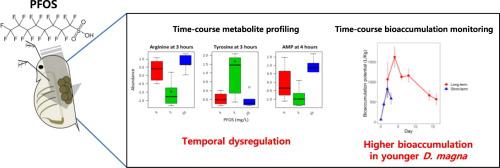Comparative Biochemistry and Physiology D: Genomics & Proteomics ( IF 3 ) Pub Date : 2020-05-26 , DOI: 10.1016/j.cbd.2020.100701 Tae-Yong Jeong 1 , Myrna J Simpson 1

|
Perfluorooctane sulfonate (PFOS) is a persistent pollutant which is potentially harmful and bioaccumulative to aquatic organisms. To evaluate the regulatory alteration of select metabolites with PFOS exposure at early and typical acute exposure periods in an aquatic indicator species Daphnia magna, the hourly abundance of the twenty-three metabolites was investigated over 24 h. To evaluate the bioaccumulation potential of PFOS at a sub-lethal concentration in D. magna, the daily accumulation into D. magna for 16 days was also evaluated. Twenty-three targeted metabolites were quantified over 1 to 4 h and 21 to 24 h of PFOS exposure using liquid chromatography tandem mass spectrometry (LC-MS/MS). Daphnid to water PFOS concentration ratios were monitored separately over different days and life stages at 0 to 76 h and 2 to 16 days of PFOS exposure. The observed metabolite abundance and bioaccumulation in the exposed groups was compared between sampling times. The results reveal that sub-lethal PFOS exposure at 2 mg/L and 20 mg/L alters regulation of arginine, tyrosine and adenosine monophosphate which are directly and indirectly related to energy status. The temporal metabolic responses observed for the early exposure period (4 h), but not for the typical acute exposure period (24 h), suggest the dysregulation potency of PFOS on metabolite regulation of D. magna and the importance of early time-course monitoring approaches. Sixteen days of bioaccumulation monitoring showed that PFOS is more bioaccumulative in younger D. magna. The observation of time-dependent bioaccumulation of PFOS in D. magna requires further studies to define its precise mechanism. Interestingly, the bioaccumulation potential of PFOS was found to be consistent between 72 h and 16 day exposure periods. No difference on the body burden to water concentration ratio during about one third of the life span time (16 days), compared to the 72 h exposure, suggests that the prolonged exposure did not increase the bioaccumulation of PFOS in D. magna. This study demonstrates that the Daphnia metabolites are rapidly responding to sub-lethal PFOS exposure and provides information on life stage and time-dependent bioaccumulation potential of PFOS. As such, metabolite regulation is a sensitive indicator to sub-lethal PFOS exposure and can be informative when combined with other measures of toxicity.
中文翻译:

大型蚤(Daphnia magna)中随时间变化的生物分子响应和全氟辛烷磺酸(PFOS)的生物蓄积。
全氟辛烷磺酸盐(PFOS)是一种持久性污染物,对水生生物可能有害并具有生物蓄积性。为了评估在水生指示物种水蚤(Daphnia magna)中早期和典型的急性暴露期,全氟辛烷磺酸暴露对某些代谢物的调节变化,在24小时内研究了二十三种代谢物的每小时丰度。为了评估D. magna中亚致死浓度下全氟辛烷磺酸的生物蓄积潜力,每日积累到D. magna中还评估了16天。使用液相色谱串联质谱法(LC-MS / MS)在PFOS暴露的1至4小时和21至24小时内对23种靶向代谢物进行了定量。在PFOS暴露0至76 h和2至16天的不同天数和生命阶段,分别监测水蚤与水的PFOS浓度比。在采样时间之间比较了暴露组中观察到的代谢物丰度和生物蓄积。结果表明,在2 mg / L和20 mg / L的亚致死性全氟辛烷磺酸暴露会改变精氨酸,酪氨酸和单磷酸腺苷的调节,这与能量状态直接或间接相关。在早期暴露期(4小时)观察到的暂时代谢反应,但在典型的急性暴露期(24小时)没有观察到,D. magna和早期时程监控方法的重要性。十六天的生物蓄积监测表明,PFOS在年轻的D. magna中具有更高的生物蓄积性。在全氟辛烷磺酸的时间依赖生物蓄积性的观察D.蚤需要进一步研究,以确定其精确的机制。有趣的是,发现全氟辛烷磺酸的生物蓄积潜力在72小时和16天的暴露时间之间是一致的。与72小时的暴露时间相比,在生命的约三分之一时间(16天)中,身体负担与水的浓度比没有差异,这表明长时间的暴露不会增加D. magna中PFOS的生物积累。这项研究表明,水蚤代谢物对亚致死性全氟辛烷磺酸暴露迅速作出反应,并提供有关全氟辛烷磺酸生命周期和时间依赖性生物蓄积潜力的信息。因此,代谢物调节是亚致死性全氟辛烷磺酸暴露的敏感指标,当与其他毒性措施结合使用时,可能会提供有益的信息。



























 京公网安备 11010802027423号
京公网安备 11010802027423号